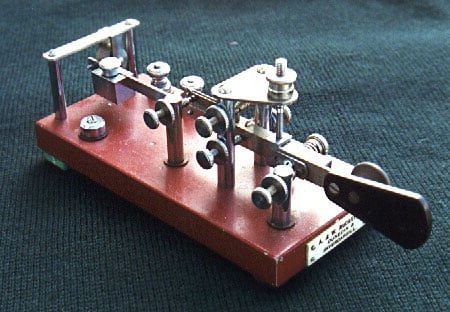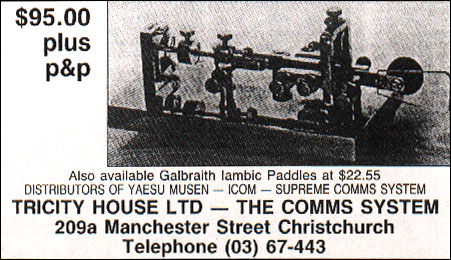Listed below are Morse Code keys known to have been mass-produced in New Zealand for use in landline telegraphy, commercial radiotelegraphy, the military, or amateur radio.
This page features semi-automatic keys (often called “bugs”). Please see the links at the bottom of the page for other types of key made in New Zealand.
If you know of other keys, or have additional information of photographs to share, please contact the editor.
A&W McCarthy bug

A&W McCarthy bug. Photo: ZL2RX
These keys are similar in design to the Vibroplex Lightning. Roger Wincer ZL2RX has one, which he purchased from A&W McCarthy’s shop in Dunedin in 1968. They told him that it was made locally – but we do not know the name of the maker.
Roger comments that the key is quite light for a bug (only 777g) and seems to have an alloy base.
“I used it at sea for many years, which is why it got damaged. It did not work well in storm conditions and often ended up being chucked about by the motion of the ship. I have to hold it down whilst keying, or screw it down to the operating table.”
 Roger has done some rebuilding of his bug, particularly around the damper frame.
Roger has done some rebuilding of his bug, particularly around the damper frame.
“What you see in the pictures is 90% original parts including screws, etc.”
The second key pictured (with the red base) is in the collection at the Com-Centre in Auckland.
The small object opposite the terminals is an extra weight for slowing the bug down. Roger’s key also has this additional weight.
AWA New Zealand bug

AWA New Zealand bug. Photo: ZL1NZ
This exceptionally rare bug, similar in design to a Vibroplex Zephyr, was made in the Wellington, New Zealand workshops of Amalgamated Wireless Australasia (AWA).
It is made of brass components mounted on a steel base with what appears to be a japanned finish. The bug weighs 1862g, not including the brass weights. The base measures 12x90x177. The overall length, including finger pieces, is 224mm and the height is 71mm.
 The original owner of the key pictured here is Mike Doig ZL2BBS, who recalls buying it from the AWA workshop shop manager, Morris Toomer.
The original owner of the key pictured here is Mike Doig ZL2BBS, who recalls buying it from the AWA workshop shop manager, Morris Toomer.
“I joined AWA in 1973 when they had a factory in Adelaide Road, Wellington. There were several licensed amateurs on the staff at that time, although most of them were VHF-only. Morris told me he had made a handful of keys for the staff as a perk job a couple of years previously. I can only recall one staff member who was interested in CW, Ray Smith ZL2AQV (SK) so I’m guessing there were only three or four of these keys produced. They weren’t made for sale, and I’ve never seen another one.”
When Mike joined AWA the company was making HF and VHF radiotelephones, and then SSB radios, mainly for the marine market. These were all designed by AWA.
“Later we built a large factory in Porirua and made a lot of consumer products under license, including Hi Fi and car stereos, as well as our radiotelephones. The company was bought by Exicom of Australia in 1989 and has since all but disappeared.”
The AWA bug has a number of interesting features:

- The base sits on a 5mm layer of hard rubber, rather than rubber feet, giving it excellent grip.
- The contact spacing is adjusted with set-screws, requiring a small screwdriver, rather than knurled screws. Other adjustments are made with slotted machine screws, although the heads are large enough to be adjusted with fingers.
- There are no special contacts on the ends of the contact screws. Rather, the ends of the screws are simply rounded off. Despite this, they make good contact, and the bug is not afflicted by ‘scratchy dits’.
- There is a circuit-closing switch, as found on older bugs that were intended for landline circuits. The AWA bug was intended for radio amateurs, yet it still has a circuit closer, unlike other radio bugs (e.g Vibroplex). I found that the switch has very little swinging room, so it would be easy to accidentally close it and key the transmitter (something a bit of electrical tape or heat-shrink tubing would prevent).
- The finger pieces can be mounted ‘high’, as in the top photo, or ‘low’ by flipping them over.
- The speed range is very low compared to other bugs, approximately 12-22 wpm with a single 38g weight. Even at its lowest speed, the bug produces a very long series of nicely timed dots (see video). The bug pictured also came with two additional weights of 35g each – for extreme QRS!
Supreme bug

Supreme bug with new chrome on base, 2022. Photo: Herman Willemsen VK2IXV
 Supreme keys were made in the 1970s and 1980s by Eric Sorensen ZL3OQ and sold by Tricity House in Christchurch.
Supreme keys were made in the 1970s and 1980s by Eric Sorensen ZL3OQ and sold by Tricity House in Christchurch.
Similar in design to a Vibroplex Original, the Supreme has a thick steel base with brass fittings and all are chromium plated. The thumbpiece is 3mm clear acrylic (or similar material) and the finger piece appears to be brown phenolic.
The photo of two keys was taken at Com-Centre in Auckland during February 2000. If you look closely, you can see that the key on the right has a sleeve over the pivot pin (see discussion below) whereas the other does not.
Dimensions (overall): 212mm long x 89mm wide x 98mm tall. Total weight: 2060g
Dimensions (base): 163mm x 89mm x 15mm
Standard adjustable weights: 2x 14g (these are quite light and it is common to see additional weights added)

An interesting feature of at least some Supreme bugs is the sleeve over the pivot pin (see photo above right). Integrated with this sleeve is a hex nut that threads onto the trunnion screw. After tightening the trunnion screw just enough to remove slop from the dot lever, one can screw down the sleeve/nut to press downward on the hinge of the dash lever, reducing any slop in that lever. Compare this with the Vibroplex arrangement shown at left, where there is no such sleeve. The dash hinge on the Vibroplex has plenty of clearance, resulting in a lot of unnecessary up/down movement.
 The bottom of the sleeve, which pushes against the top of the dash hinge, is rounded, presumably to minimise friction when making dashes.
The bottom of the sleeve, which pushes against the top of the dash hinge, is rounded, presumably to minimise friction when making dashes.
There is a similar arrangement for the lower end of the pivot, with a trunnion screw inserted from the bottom of the base, then passing upward through a short sleeve with rounded top shoulders on which the bottom of the dash hinge bears. Once assembled, all adjustments were likely done via the top trunnion screw and upper sleeve/nut.
Photos: ZL1NZ, except where noted

This Supreme bug has a yellow thumb piece. All the others I’ve seen have a clear thumb piece. Photo: F9WT
 In the 1977 NZART Callbook Supreme bugs were advertised at $21.85. In 1986 they cost $72.50, and a year later they had gone up to $95.
In the 1977 NZART Callbook Supreme bugs were advertised at $21.85. In 1986 they cost $72.50, and a year later they had gone up to $95.
Pictured: an advertisement in Break-In magazine, October 1987
Supreme non-magnetic RNZN bug

Before you dismiss the photo above as “just another of Eric Sorensen’s NZ-made Supreme bugs“, please take note of the special identification plate on top of the base.
It reads:
SPEED KEY
ROYAL NEW ZEALAND NAVY
Serial No. (not legible)
And if you were lucky enough to get your hand on this bug, you might notice that it feels different. That’s because the main pieces are plated brass, rather than the customary steel. The only ferrous metal parts are the dot and dash return springs, the pendulum and a couple of small screw/nut combinations. As a result, this bug is (almost) non-magnetic.
The key weighs about 250g more than the standard version.
It also has four feet instead of three as found on the popular amateur radio version sold by Tri-City House in Christchurch.
A very special bug indeed, from the collection of telegraphist Maurie Challinor ZL1FK of Auckland. Maurie said he did not know why the Navy used a non-magnetic bug. Could it have been for use aboard a minesweeper?
Thanks to Herman VK2IXV for compiling this information.
1928 Copy of Vibroplex Original

1928 copy of a Vibroplex Original bug by Ron Venables
The following story appeared in Gary Bold ZL1AN’s Morseman column in Break-In magazine of February 1989.
One weekend early in 1928, Ron Venables OZ3BZ* borrowed a Vibroplex semi-automatic key (a “bug”) from a US freighter berthed in the port of Lyttleton. He disassembled it, took measurements and made mouldings for all the parts. Then he reassembled it and returned it.
Within a few weeks he had manufactured and nickel-plated all the parts for six keys. He presented one to Dan Wilkinson ZL2AB, who mounted it on a three-ply base. Dan found that the adjustment was not difficult and he really appreciated the ease of operation compared to the old hand-key.
After 60 years use the contacts were worn but the key still performed as well as the best. This key is now in the collection at Kapiti Coast Museum, Waikanae, near Wellington and is sometimes used by the operators of the amateur radio station at the museum.
In Gary’s June 1989 column, it was reported that Wally ZL2GG, was offered one of the new clones for 25 shillings. By the time Wally had saved his five shillings-a-week pocket money, the keys had all been sold. Wally said that Ron was a craftsman and had an eye for mechanical finish and detail.
The fate of the other five keys is unknown. Have you seen one anywhere?
* In 1928 OZ3 was a NZ prefix. Ron later became ZL3AE.



